 Years ago after graduating from college, I wanted to pursue a career that would allow me to do something creative, something hands-on. There were a lot of directions I could have taken, but I had a unique opportunity through a family connection to apprentice with a 3rd generation Greek goldsmith who had recently immigrated to the United States. It was a small family business, and they specialized in designing and fabricating custom jewelry entirely by hand. I knew nothing about jewelry or metal work, but after my first day I was completely hooked.
Years ago after graduating from college, I wanted to pursue a career that would allow me to do something creative, something hands-on. There were a lot of directions I could have taken, but I had a unique opportunity through a family connection to apprentice with a 3rd generation Greek goldsmith who had recently immigrated to the United States. It was a small family business, and they specialized in designing and fabricating custom jewelry entirely by hand. I knew nothing about jewelry or metal work, but after my first day I was completely hooked.
My apprenticeship lasted 2 years and 3 months before I moved on to a new opportunity. That’s not a lot of time considering it easily takes 8 to 10 years or longer to become truly proficient as a bench jeweler. As it turned out, my career path led me away from jewelry bench-work as a daily profession. However, I never completely gave it up, and some years later was able to outfit a small shop with the tools and equipment needed to make enough jewelry to keep the female members of my family content.
 The vast majority of the vintage tool market focuses on tools for woodworking. Yet while many modern woodworkers use power tools more or less exclusively, silversmiths and goldsmiths still use hand tools for most of their work. While electricity has added considerable convenience, many of the hand tools used by gold and silversmiths today haven’t changed substantially in a couple hundred years or longer. For tool junkies like you and me, that opens up a whole wealth of fascinating and elegant tools for us to appreciate.
The vast majority of the vintage tool market focuses on tools for woodworking. Yet while many modern woodworkers use power tools more or less exclusively, silversmiths and goldsmiths still use hand tools for most of their work. While electricity has added considerable convenience, many of the hand tools used by gold and silversmiths today haven’t changed substantially in a couple hundred years or longer. For tool junkies like you and me, that opens up a whole wealth of fascinating and elegant tools for us to appreciate.
The Work Bench
 Not at all unlike a woodworkers bench, a goldsmith’s, silversmith’s, or engraver’s bench is the centerpiece of his work space. It is my understanding (through my training) that the craftsman traditionally constructed his own bench. I honestly don’t know if this is true or not, but given the typical complexity of such benches and the fact that they are so uniquely and uncommonly personal to the individual, it would not at all surprise me. Commercially made benches are available today through jewelry tool distributors like Gesswein and Rio Grande, but they tend to be too lightweight and of mediocre construction for anything more than occasional use.
Not at all unlike a woodworkers bench, a goldsmith’s, silversmith’s, or engraver’s bench is the centerpiece of his work space. It is my understanding (through my training) that the craftsman traditionally constructed his own bench. I honestly don’t know if this is true or not, but given the typical complexity of such benches and the fact that they are so uniquely and uncommonly personal to the individual, it would not at all surprise me. Commercially made benches are available today through jewelry tool distributors like Gesswein and Rio Grande, but they tend to be too lightweight and of mediocre construction for anything more than occasional use.
 I built my bench about 10 years ago (shown at the right). I designed it specifically for my height and work style, with a 3-1/2″ thick butcher block top of solid oak. Weight is important in these benches – heavier is better. You can see in the photo there are three tool/supply drawers, and below them two very wide and shallow drawers. These are lap drawers that catch the metal filings as they fall, extremely important when working with precious metals. The filings and scraps are all collected and sent to a refinery for reclamation. Even old sandpaper is saved. I built my bench with two lap drawers for convenience and practicality, as I often work on more than one project at a time and sometimes work with both precious and non-precious metals. It’s better to keep the two separated. Naturally, if I had it to do over I would do several things differently. The drawer face on the far left doesn’t match the other two very well, and it bugs me. I also made some stupid mistakes with some of the framework, but all aesthetic. I was so consumed with the functional aspects that I didn’t give enough thought to how it would all look.
I built my bench about 10 years ago (shown at the right). I designed it specifically for my height and work style, with a 3-1/2″ thick butcher block top of solid oak. Weight is important in these benches – heavier is better. You can see in the photo there are three tool/supply drawers, and below them two very wide and shallow drawers. These are lap drawers that catch the metal filings as they fall, extremely important when working with precious metals. The filings and scraps are all collected and sent to a refinery for reclamation. Even old sandpaper is saved. I built my bench with two lap drawers for convenience and practicality, as I often work on more than one project at a time and sometimes work with both precious and non-precious metals. It’s better to keep the two separated. Naturally, if I had it to do over I would do several things differently. The drawer face on the far left doesn’t match the other two very well, and it bugs me. I also made some stupid mistakes with some of the framework, but all aesthetic. I was so consumed with the functional aspects that I didn’t give enough thought to how it would all look.
Common Bench Tools
 In terms of breadth and depth of assortment, woodworkers would be hard pressed to compete with the average goldsmith or silversmith for quantity of tools. In addition to files of various shapes and sizes, there are any number of pliers, hammers, saw blades, hundreds of rotary tool bits, polishing wheels, bench blocks, mandrels, staking tools, torches, tweezers, magnifiers… the list goes on and on. Further, like blacksmiths, goldsmiths and silversmiths must make many of the tools they use.
In terms of breadth and depth of assortment, woodworkers would be hard pressed to compete with the average goldsmith or silversmith for quantity of tools. In addition to files of various shapes and sizes, there are any number of pliers, hammers, saw blades, hundreds of rotary tool bits, polishing wheels, bench blocks, mandrels, staking tools, torches, tweezers, magnifiers… the list goes on and on. Further, like blacksmiths, goldsmiths and silversmiths must make many of the tools they use.
 Fundamental to virtually every bench is a wooden bench pin, steel bench block, jeweler’s saws, pliers, hammers and files. The bench pin is a wedge-shaped block that protrudes from the front of the bench and serves as a support for filing and sawing, as well as a leverage point for everything else. Steel bench blocks sit on top of the bench, are dead flat, and serve as all-purpose platforms for flattening and shaping softer precious metals. Jeweler’s saws come in a variety of depths. The interchangeable saw blades are positioned with the teeth pointing toward the handle, so they cut on the down (or pull) stroke.
Fundamental to virtually every bench is a wooden bench pin, steel bench block, jeweler’s saws, pliers, hammers and files. The bench pin is a wedge-shaped block that protrudes from the front of the bench and serves as a support for filing and sawing, as well as a leverage point for everything else. Steel bench blocks sit on top of the bench, are dead flat, and serve as all-purpose platforms for flattening and shaping softer precious metals. Jeweler’s saws come in a variety of depths. The interchangeable saw blades are positioned with the teeth pointing toward the handle, so they cut on the down (or pull) stroke.
Because they are used for precise work, jeweler’s tools tend to be precision tools. Measurements are typically in tenths or thousandths of a millimeter, and when working with metals that cost almost $2,000 and ounce, material efficiency and waste reduction is an obsession. Every precious metal dust particle is quite literally considered and every effort is made to recover as much as possible.
Heavier Shop Equipment
 Smiths also use a variety of heavy shop equipment depending on the manufacturing techniques they employ. Rolling mills like the one shown here roll out sheet stock and wire to be used in fabrication. It is a slow and laborious process. Some jewelers use casting equipment to cast wax models into gold, silver, or platinum. The wax model is encased in plaster with an attached sprue. The wax is melted out leaving a cavity in which the liquid metal is injected through either a vacuum or centrifugal force. Production shops use CAD computers, computerized crucibles and casting machines, and laser soldering devices costing tens of thousands of dollars.
Smiths also use a variety of heavy shop equipment depending on the manufacturing techniques they employ. Rolling mills like the one shown here roll out sheet stock and wire to be used in fabrication. It is a slow and laborious process. Some jewelers use casting equipment to cast wax models into gold, silver, or platinum. The wax model is encased in plaster with an attached sprue. The wax is melted out leaving a cavity in which the liquid metal is injected through either a vacuum or centrifugal force. Production shops use CAD computers, computerized crucibles and casting machines, and laser soldering devices costing tens of thousands of dollars.
Alongside every goldsmith bench is a small torch. Since my bench is in my home, large propane and oxygen tanks were not an option, so I constructed a portable tote for the small disposable tanks available at hardware stores. This works fine for soldering jewelry, but for melting metal or larger jobs, a standard size setup is necessary.
 Every metal worker needs a polishing machine, and mine is typical of those found in smaller shops. It is a floor standing model with hoods and a powerful dust collection unit. This not only keeps the work space cleaner, but captures most of the particulates, which are comprised of a surprisingly high percentage of fine metal material. This too is sent for refining and metal reclamation.
Every metal worker needs a polishing machine, and mine is typical of those found in smaller shops. It is a floor standing model with hoods and a powerful dust collection unit. This not only keeps the work space cleaner, but captures most of the particulates, which are comprised of a surprisingly high percentage of fine metal material. This too is sent for refining and metal reclamation.
Stone Setter’s and Engraver’s Tools
An engraver’s bench is virtually identical to a jeweler’s bench. However, an engraver will have a special ball vise that rotates 360º as he works. His tools, called gravers, have profiles of different shapes and thicknesses, much like wood carving or turning tools. Before he begins cutting metal, the engraver typically applies china white, a chalk-like substance that let’s him draw on the metal. The intended design or inscription is very carefully hand drawn, and the engraver then follows the lines with the gravers, removing thin metal curls. Some gravers are used for letters, others for outlines, and others still for removing or defining the background. Like goldsmiths and silversmiths, engravers spend many years, even decades, mastering their craft. It is a beautiful and dying art.
 You might be surprised to learn that many of the tools used by engravers are also used by stone setters. As mentioned above, gravers are used to remove metal. In certain setting styles they can also be used to create beads that form prongs for gemstones. Pavé settings start with a drilled hole that is then tapered with a small bur shaped much like a counter-sink bit. “Prongs” are then engraved up from the surrounding metal to form a tiny bead that covers the edge of the stone. Now, if you think that sounds complicated, consider this… because Pavé settings feature many stones in extremely close proximity, each bead is formed to cover the bezel of not one or two, but three adjacent gemstones. This type of setting is extremely precise and requires extraordinary skill.
You might be surprised to learn that many of the tools used by engravers are also used by stone setters. As mentioned above, gravers are used to remove metal. In certain setting styles they can also be used to create beads that form prongs for gemstones. Pavé settings start with a drilled hole that is then tapered with a small bur shaped much like a counter-sink bit. “Prongs” are then engraved up from the surrounding metal to form a tiny bead that covers the edge of the stone. Now, if you think that sounds complicated, consider this… because Pavé settings feature many stones in extremely close proximity, each bead is formed to cover the bezel of not one or two, but three adjacent gemstones. This type of setting is extremely precise and requires extraordinary skill.
Watchmaker’s Tools
Watchmakers are an entirely different breed; the level of precision required of a true watch maker is unparalleled. The market today is dominated by disposable quartz movements, so old-fashioned watchmaking is a dwindling profession. There are only a handful of companies at the very highest end that even still make mechanical movements. Sadly, fewer and fewer young people are willing to invest the time it takes to become proficient to work on mechanical watches. While the earning potential for the highest skill levels is significant, entry-level workers are not highly compensated.
Watchmakers employ a dizzying array of tools, parts, and devices. The traditional centerpiece to the watchmaker’s bench is the lathe (shown in the photo above). Employing many of the same skills and techniques of the goldsmith, watchmakers demonstrate proficiency in the fine jewelry arts as well as the mechanical skills required to build and repair watches. It’s not surprising that so many individual jewelry proprietors of the last century were generalists in this regard, working on both jewelry and watches as a service to customers.
 Watchmaker’s benches typically differ from jeweler’s benches in both function and design. Generally forgoing the lap drawer, watchmaker’s benches are easily identified by the plentiful small drawers and cabinets for storing parts and tools. Earlier benches often had a foot treadle for powering the watchmaker’s lathe built right in. These were often magnificent pieces of furniture, with a charm and character unique to the profession. It was also common for them to have lockable enclosures such as hinged lids or roll tops to prevent opportunistic theft of valuable tools and materials.
Watchmaker’s benches typically differ from jeweler’s benches in both function and design. Generally forgoing the lap drawer, watchmaker’s benches are easily identified by the plentiful small drawers and cabinets for storing parts and tools. Earlier benches often had a foot treadle for powering the watchmaker’s lathe built right in. These were often magnificent pieces of furniture, with a charm and character unique to the profession. It was also common for them to have lockable enclosures such as hinged lids or roll tops to prevent opportunistic theft of valuable tools and materials.
Summary
This is by no means a comprehensive or complete review of all the tools used by these craftsmen. In fact, I’ve barely scratched the surface. Clearly, woodworking tools hold a broader appeal, probably because the average person can better relate to their use. Tools of the jeweler, goldsmith, silversmith, engraver, and watchmaker tend to be viewed as a bit more exotic and intended for very specific, and often unfamiliar, uses to most people. I suppose that’s true, but only to a limited extent. I use many tools in woodworking that were designed for the jewelry bench, simply because they suit a particular need better than anything else available. Nevertheless, exotic or not, it’s easy to appreciate their form and function and place in the realm of fine hand craftsmanship.

***
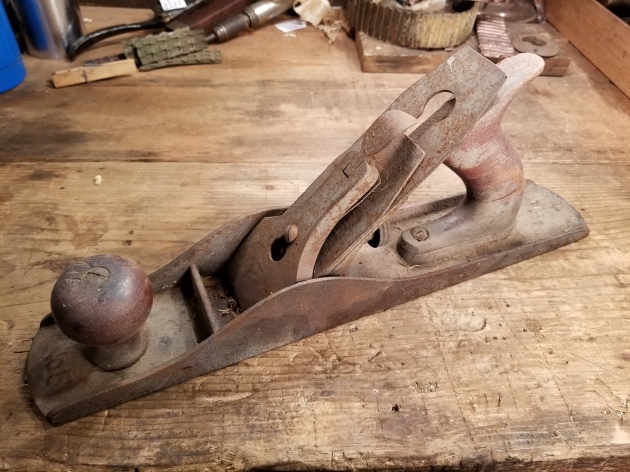
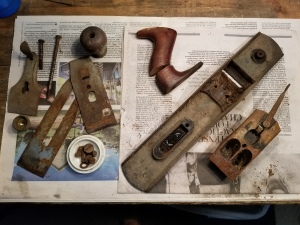


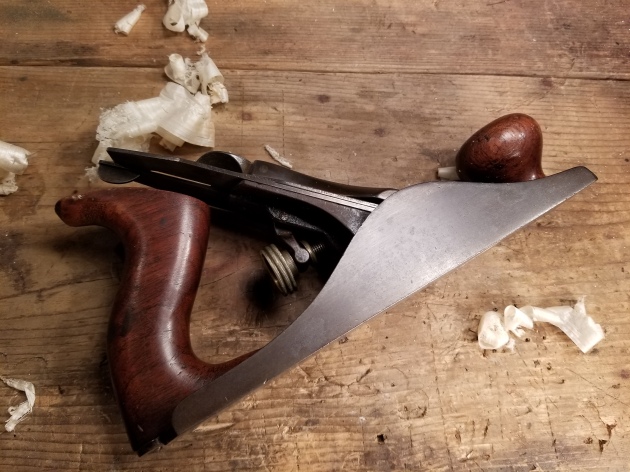

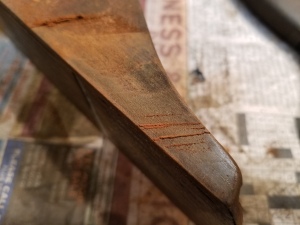
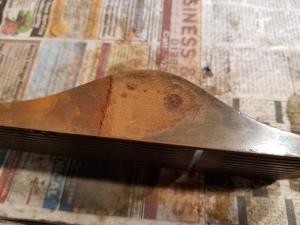















 Every metal worker needs a polishing machine, and mine is typical of those found in smaller shops. It is a floor standing model with hoods and a powerful dust collection unit. This not only keeps the work space cleaner, but captures most of the particulates, which are comprised of a surprisingly high percentage of fine metal material. This too is sent for refining and metal reclamation.
Every metal worker needs a polishing machine, and mine is typical of those found in smaller shops. It is a floor standing model with hoods and a powerful dust collection unit. This not only keeps the work space cleaner, but captures most of the particulates, which are comprised of a surprisingly high percentage of fine metal material. This too is sent for refining and metal reclamation.







